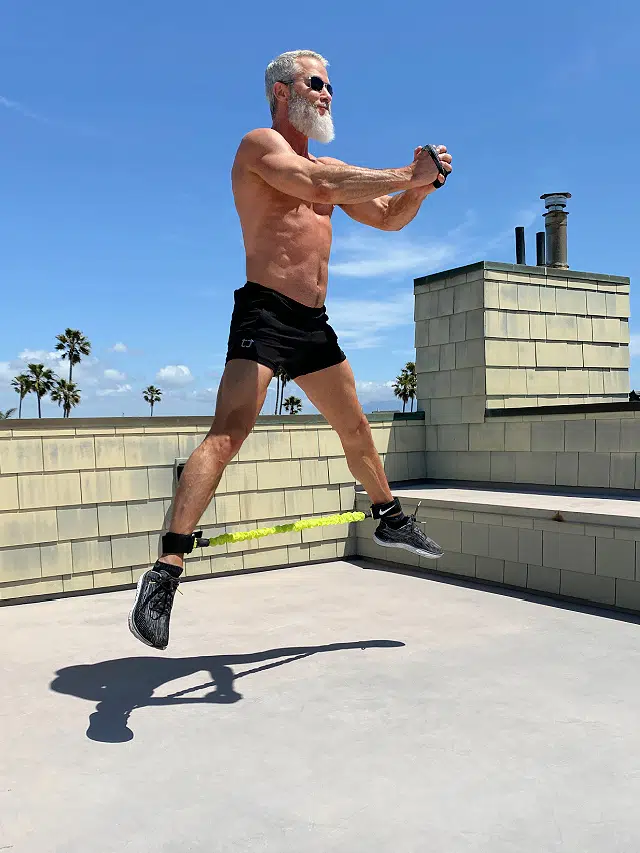Here are the best leg exercises using resistance bands. This thigh workout effectively adds sculpted muscle, builds lower body strength, and promotes fat loss.
This thigh workout is different from others because it’s completed in a circuit-training format, so your heart rate remains elevated and more calories are burned.
The result is that your thigh muscles become more visible and defined. They are being strengthened, and the fat cells and skin over them are being shrunk and tightened.
The video below will prove helpful.
What to Do About Fat Legs
It can be empowering to use your free will and discipline to permanently change your body composition – as long as it’s done with a positive attitude.
In truth, bodies come in all shapes and sizes, and that diversity is what makes life beautiful.
Almost everyone in the developed world has a little excess body fat. A bit of surplus adipose tissue doesn’t mean you have to succumb to shame or societal pressure about your own body image.
However, if you’re coming from a place of empowerment and you’re excited about the idea of improving your health, there are several things you can try if you want to reduce the size of your legs.
Engage in regular physical activity. Exercise can help you burn fat and sculpt muscle, which can help to reduce the size of your legs.
Focus on activities that engage your leg muscles, such as walking, running, cycling, and strength training – including the thigh resistance-band exercises I outline below (see video, too).

Adopt a healthier diet. A balanced diet that is low in calories and saturated fats can help you lose weight and reduce the size of your legs. Eat plenty of vegetables and lean proteins, and limit your intake of processed foods and simple sugars.
When you eat a calorie deficit – fewer calories consumed than are being burned – you absolutely will lose thigh fat.
Ample hydration is key. Drinking enough water helps flush out waste products and impurities in the blood and reduce bloating, which may make your legs appear slimmer. Aim for at least 8 cups of water per day.
Compression garments can be helpful. Wearing compression garments, such as compression stockings or leggings, can help to reduce the appearance of cellulite and make your legs look slimmer. Plus, they help to prevent varicose veins.
Thigh Fat Reduction Exercises
It’s considered impossible to “spot reduce” fat from specific areas of your body, including your thigh.
To reduce the size of fat deposits around your legs, you need to focus on losing weight and building muscle overall through a combination of diet and exercise.
However, as someone who has been training clients for decades, I can tell you this. When there is muscle underneath the fat, the skin’s texture just looks better. Tauter.
So, though technically spot reduction is not a real thing, changing the appearance of your thighs and the skin texture over your legs can be improved with thigh exercises, in my opinion.
Experience has shown me that fat just seems to look less watery and jiggly when there is ample muscle tone underneath.
Try These Leg Exercises with Resistance Bands for Gravity-Defying Glutes and Powerful Thighs
Strength training is a vital part of overall health.
In particular, the gluteal muscles can weaken and droop as we age – negatively affecting pelvic alignment and causing lower back problems.
These leg exercises help keep your buttocks lifted, developed, and well-shaped – while firming and strengthening your quadriceps, hamstrings, inner thighs, outer thighs, and calves.
Your lower body – especially the glute muscles – responds positively to exercises done with resistance bands.
This workout is for women or men and can be modified to match any fitness level. See the videos lower within this article to see exactly how each exercise can be performed.
Why You Should Use Resistance Bands for Glute Isolation Exercises and Thigh Workouts
Your body gets accustomed to the same old exercises.
Many people get into a rut with their workouts. Though they might make a few changes here and there, for the most part, people do the same workouts over and over again.
This creates complacency – and results lessen over time.
This is especially true with leg muscles, including glutes, because the lower body was designed to be used in many ways. So limiting movement patterns is going against what nature intended.
Resistance bands to the rescue!
Resistance bands are a convenient and inexpensive way to add instant variety to previously stale movement patterns:
- They allow for a more organic range of motion (instead of strictly limiting the direction as many gym machines do).
- Unlike weights, resistance bands increase tension as your muscle approaches the point of peak contraction!
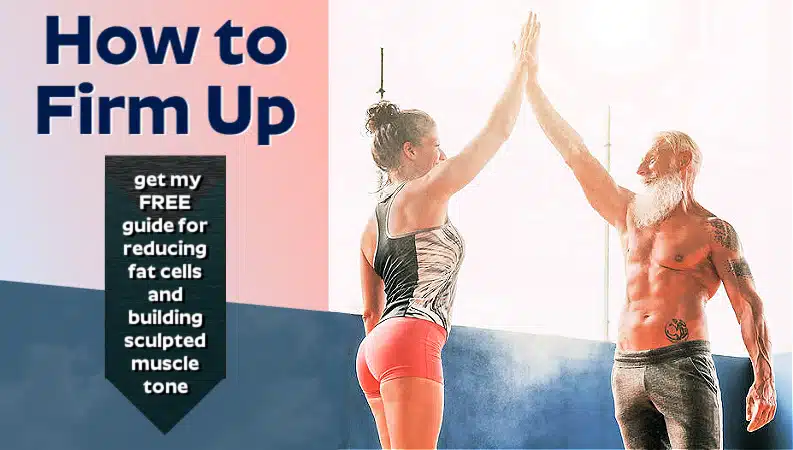
Resistance bands benefit the human physique because they activate smaller muscles, which facilitate finely tuned movements, stabilize joints, help rotate joints, and help larger muscles perform.
The genius of resistance bands is they work you bone-deep from the inside out, training the more obvious, major muscle groups and improving the smaller, stabilizing muscles. This can make all the difference.
Remember that leg muscles are the biggest muscle area in your body, and when you move them, you automatically utilize more calories.
Your quadriceps and calves, in particular, are like hungry monsters that eat calories for energy. These lower-body muscles provide a metabolic after-burn – they keep utilizing calories even after the workout stops.
The Warm-Up Circuit Using Resistance Bands for Your Lower Body
To make these thigh exercises even more effective – and fun – they’re presented in a circuit-training format.
With standard bodybuilding at the gym, you do a few sets of each exercise, taking a few minutes to rest in between each set.
This way of working out can become dull, as your heart rate never builds momentum.
A circuit, however, is a group of prescribed exercises done consecutively.
With this lower-body circuit-training workout, you use resistance bands for each exercise with no rest between isolation exercises until you complete a full circuit.
Then, and only then, do you rest for 2 minutes before repeating the same circuit.
Each circuit is repeated three times (before moving on to a brand-new circuit).
You don’t have to use the exact brand of resistance bands used in the following photos and video.
Compared to other gym equipment, resistance bands are very cheap. You can order all types of bands online (from Amazon or Perform Better, for instance).
If your band looks different from the one in the photo, you can still probably make the exercise work with a little patience and creativity.
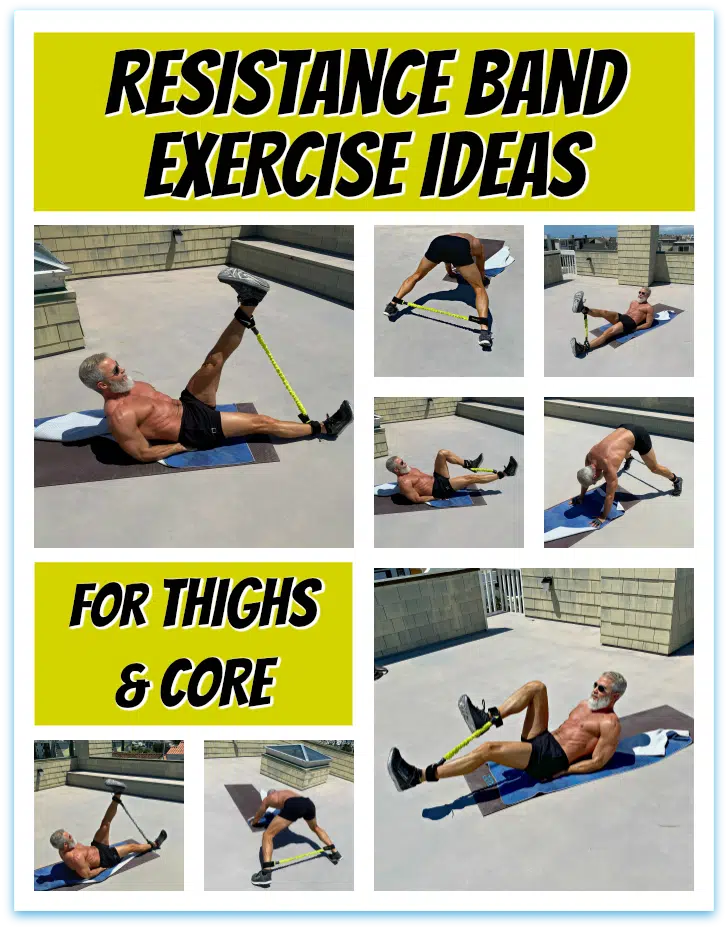
Reclining Straight-Leg Lift
Palms braced, face down, under your hips to create stability for your lower back. Draw your navel in tightly, and lift one straight leg up and down – foot flexed.
Imagine a laser beam of energy shooting out of your heel to keep the leg muscles active.
I sometimes use a cuffed band (as pictured above), but a regular short loop without cuffs will work just as well.
20 repetitions on each leg.
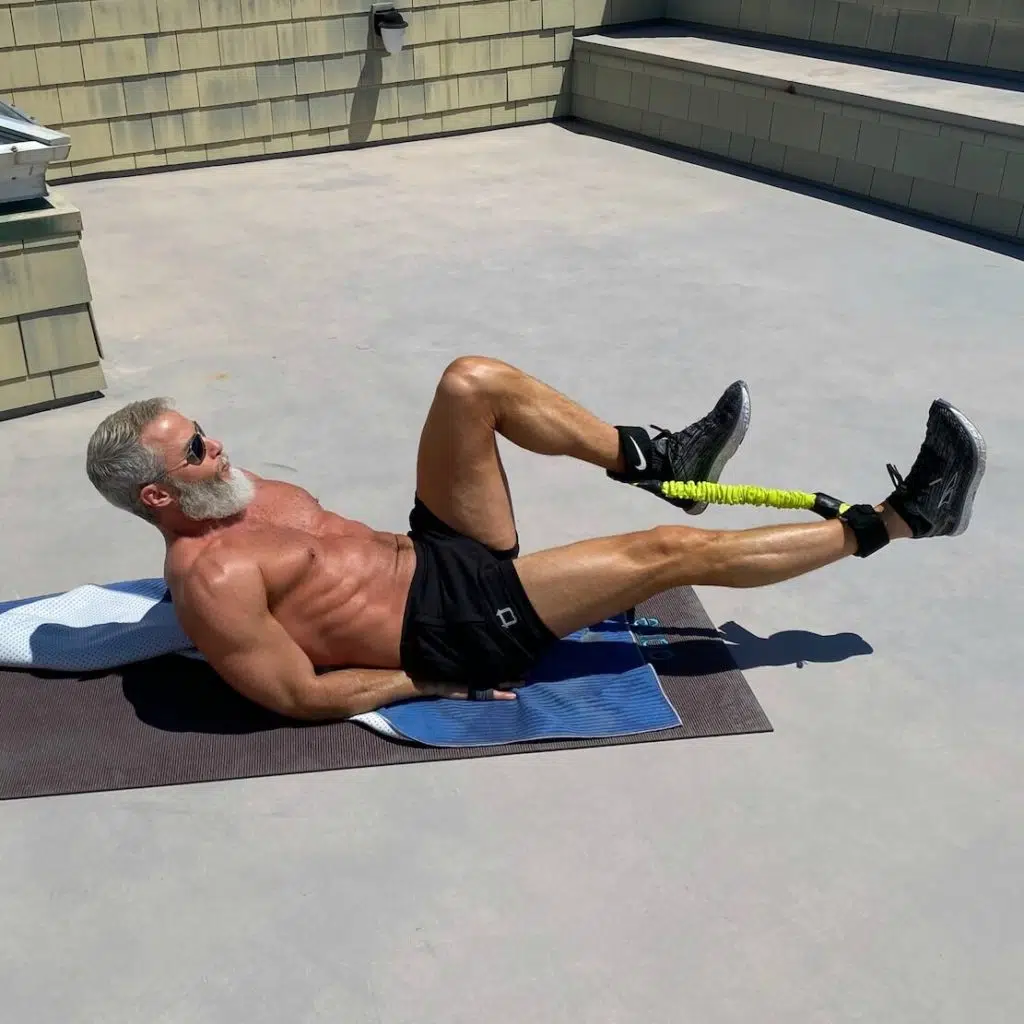
Reverse Mountain Climbers with Resistance Bands
Same positioning as above, only this time you’re bicycling the legs.
40 reps total.
Use either a cuffed band or a regular short-looped resistance band (without cuffs).
SECRET TIP: Your weekly workouts bring results, yes, but your workouts, when combined with an anti-inflammatory diet, will bring exponential results. For most people, this is the missing piece to the puzzle.
When you eat a mediocre diet, your workouts are just burning some calories you’ve already consumed that day. But when your nutrition is on-point, your workouts accomplish so much more. I can’t emphasize this point enough.
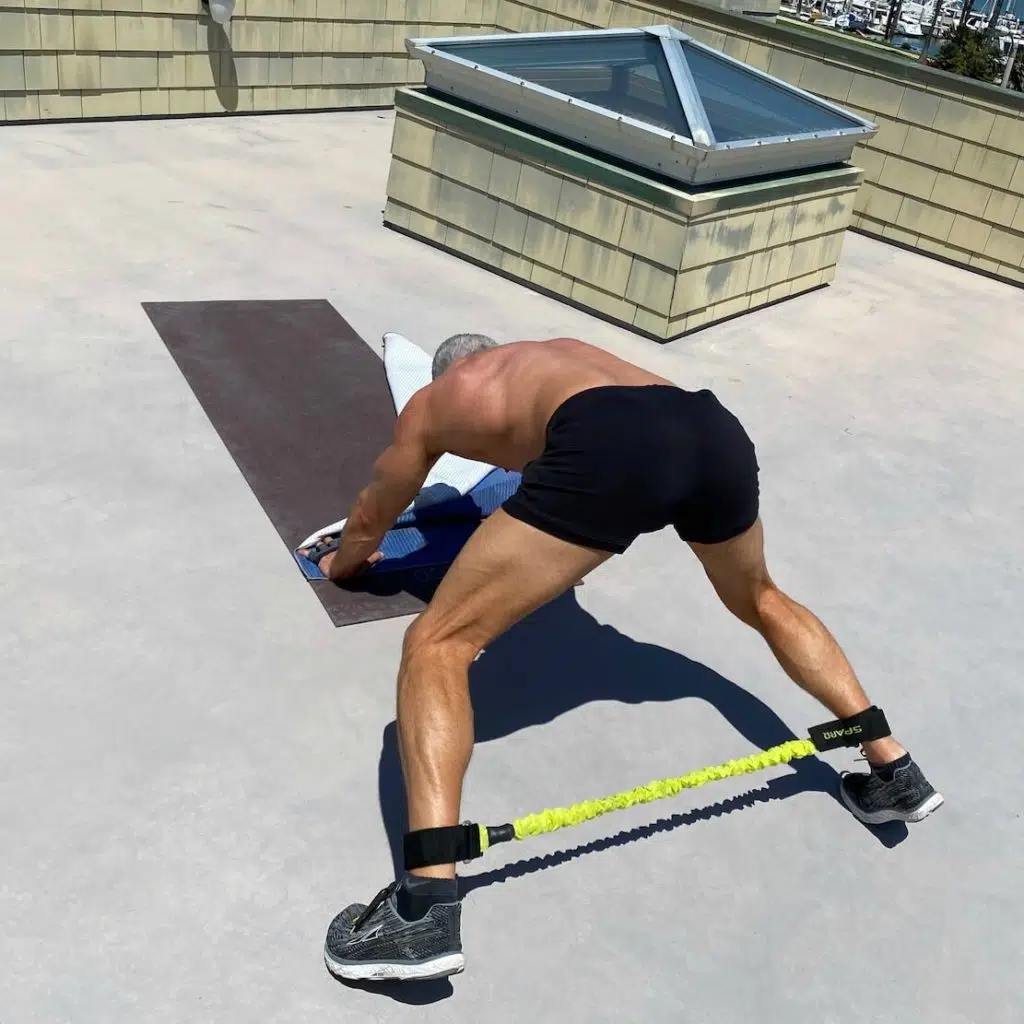
Best Glute Isolation Exercises: Prone Jump-Aparts
Facedown, hands braced on the ground, jump your feet apart and together.
Any looped band can work for this exercise (it doesn’t have to be the cuffed kind pictured above).
Imagine directing your body’s energy up toward the sky to keep your body weight off your wrists. Stay light on your feet.
Up to now, you’ve been warming up your abdominals and quads. Still, in this exercise, you’re beginning to involve the glutes – this is important because there are more focused buttocks exercises in future circuits.
Keep your navel pulled up tightly!
20 reps.
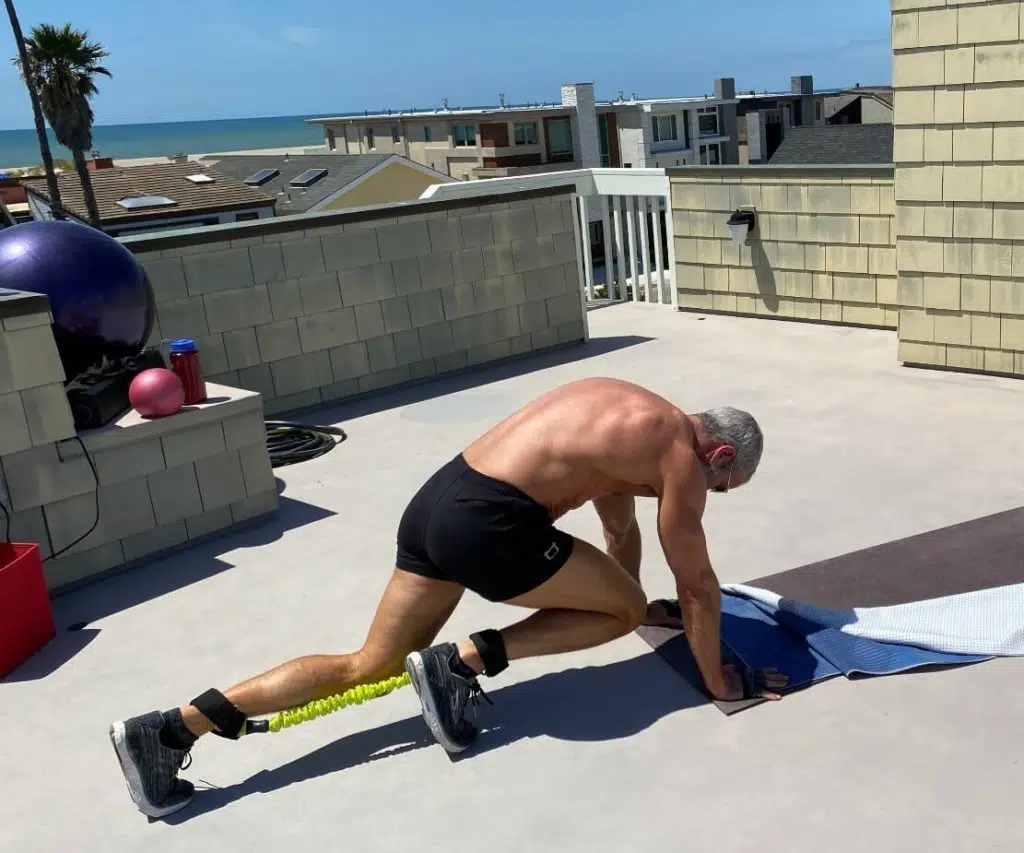
Mountain Climbers for the Powerful Thigh (regular)
For mountain climbers, the trick is to be light on your feet. Use the power of your core to keep your body weight off the ground.
If you don’t have cuffed resistance bands, no problem. This exercise can be done without a band.
40 reps (20 each side).
Second Circuit Using Resistance Bands for Leg Development
Your intensity should build for the second circuit, so push yourself a bit further if you’re able.
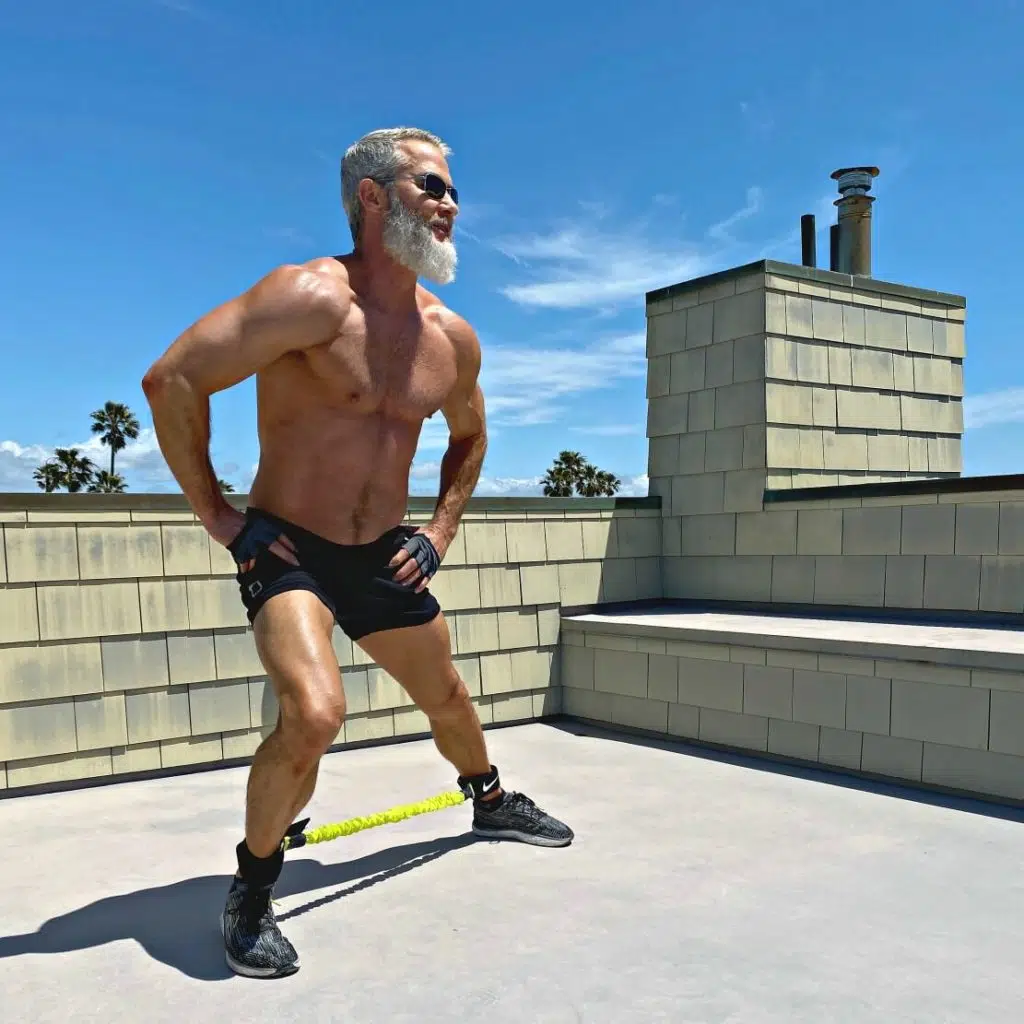
Side Lunges with Resistance Bands
Use whichever type of band works best for you. Start with feet together, then step one leg up-and-out in an exaggerated manner – lunging to the side.
Maintain length in your torso and neck the entire time.
14 repetitions on each side.
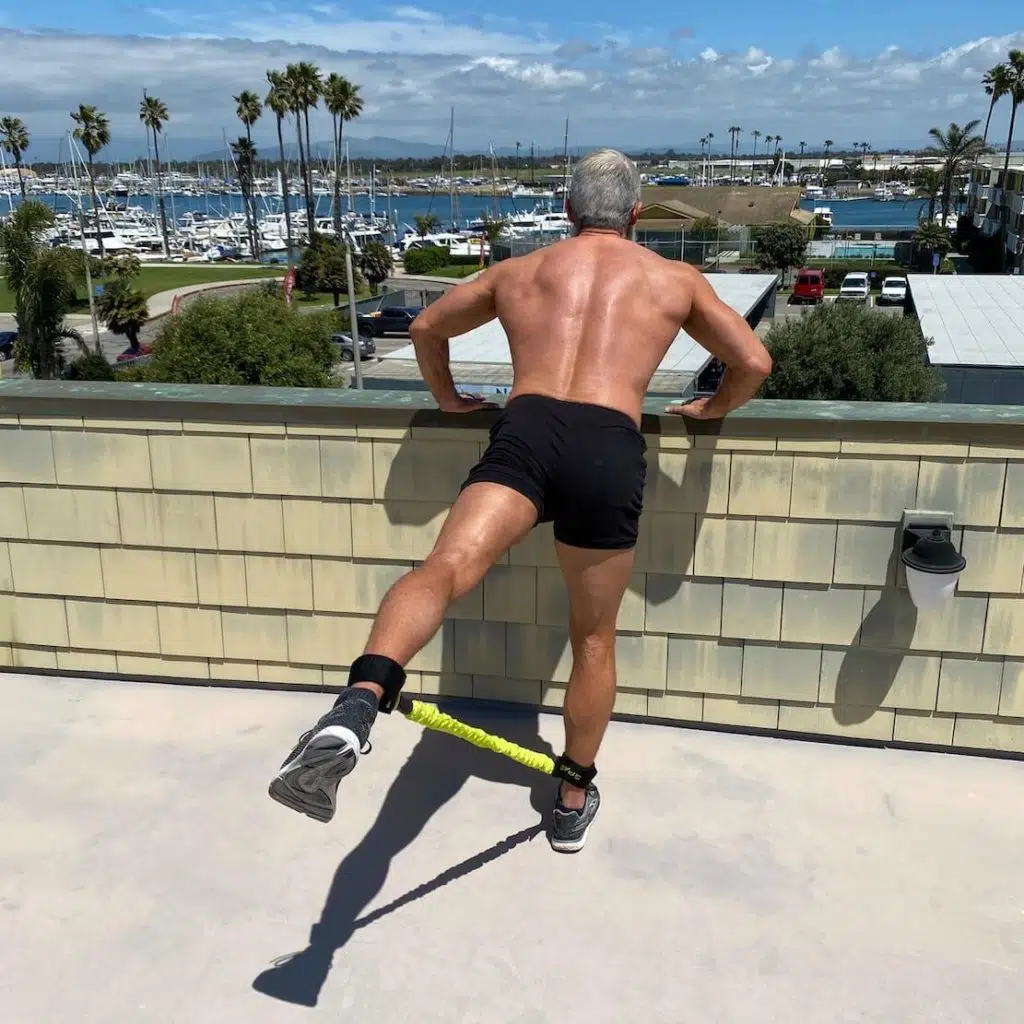
Standing Leg Lift for Thigh Isolation
Turn your pancakes into peaches! Few things look more aesthetically pleasing than powerful buttocks muscles.
Want your knees and lower back to stay healthy even as you get older? Then you’ll need to maintain a stable pelvis (something many modern humans lack). A surefire way to help maintain a stable pelvis is to keep your glute muscles strong. This exercise will help.
Lean forward slightly, bracing your arms (on a wall or rail) for support. Soften your supporting knee as you lift the other leg behind you.
Keep the working leg very straight and slightly turned in (toe pointing towards the floor).
16 reps each leg.
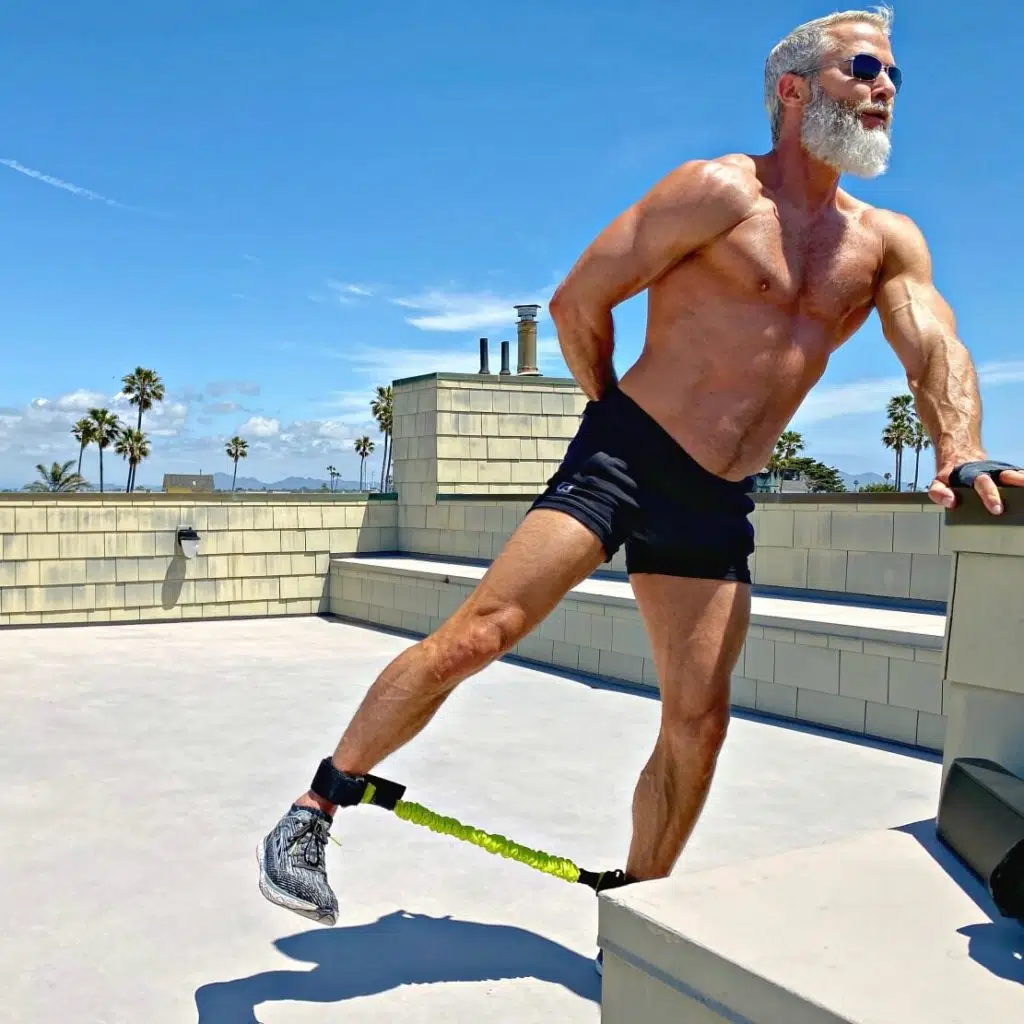
Best Glute Isolation Exercises: Standing Side Leg Lifts for Outer Thighs
Similar to the previous exercise, except this time you’re pressing your leg up to the side instead of directly back.
16 reps each leg.
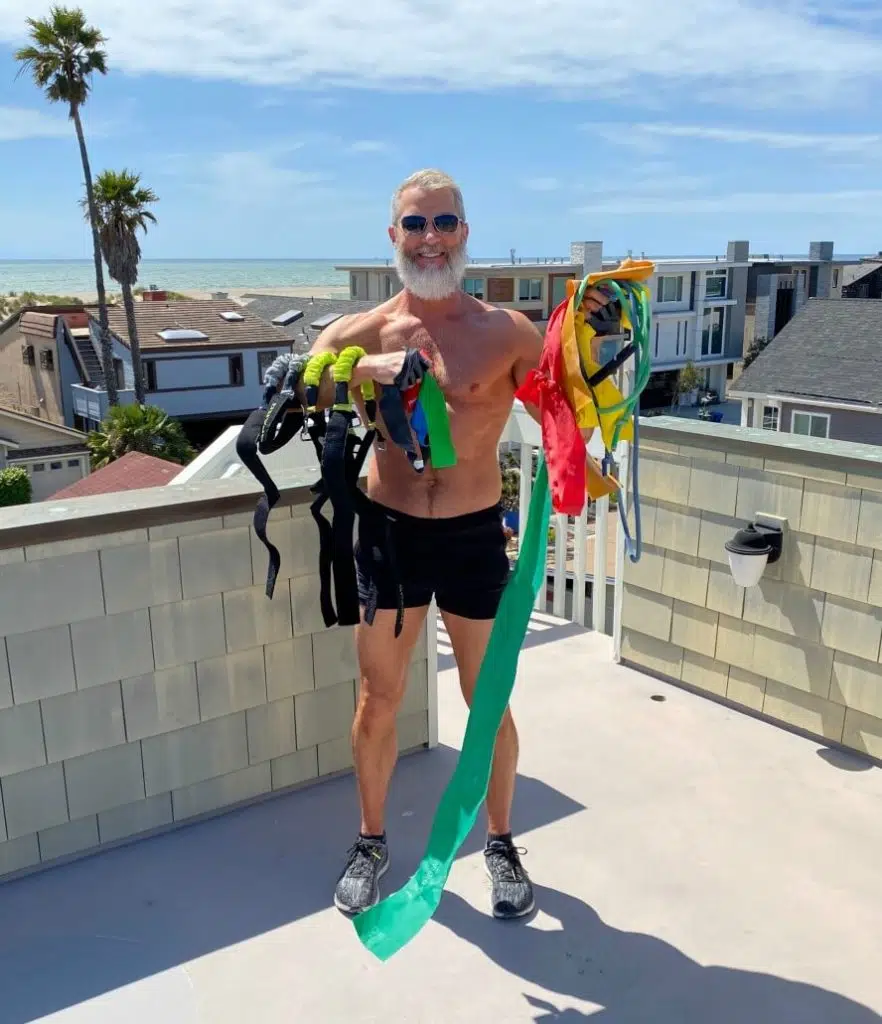
Lower Body “Cheerleader Jumps” with Resistance Bands
Jump up like you’re making a star shape with your body.
Your legs move quickly because they start together on the ground and end together on the ground.
Your thighs have to move fast and sharp, like Ginsu knives.
12 reps.
Third Circuit Using Resistance Bands for Best Leg Exercises
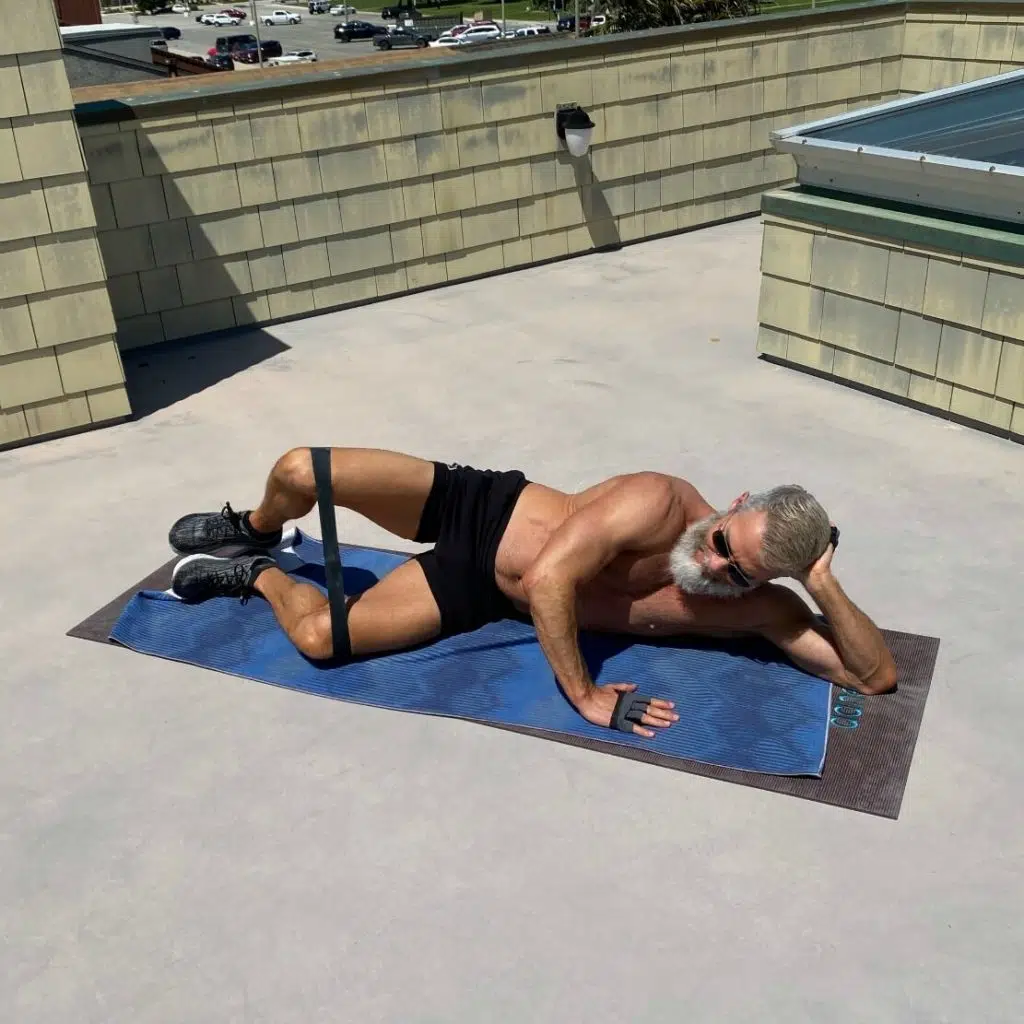
Thigh Can Openers Using Resistance Bands
A short, looped band will work well for this exercise. Place it just above the knees. On your side, you stack bent knees upon one another, then peel back the top knee – hitting that upper outer thigh and glute.
20 reps each side.
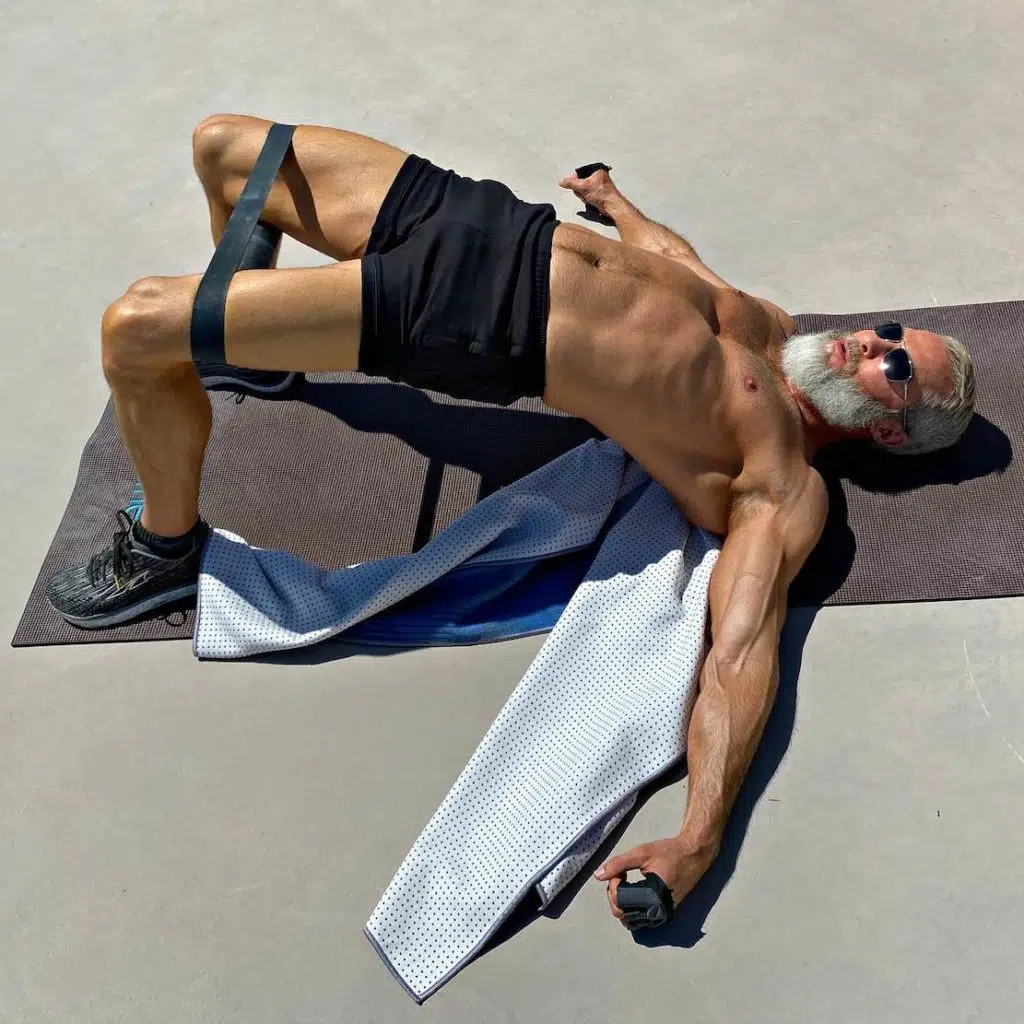
Glute Bridge
With this exercise, you need to be mindful of your neck.
If you’re already trim, fit, and have a strong core, your cervical spine should be fine – especially if you already enjoy baseline spinal mobility.
However, if you’re feeling stiff or weighing over 200 pounds – or currently carrying a high percentage of body fat – you want to move more slowly and perhaps not lift your hips quite so high during each repetition.
Use common sense. It’s a highly effective exercise, as long as you listen to your body’s needs.
The point is to utilize your core and glute muscles to pull the weight of your body toward the direction of your feet (away from the neck). Your neck should not have to support the entire weight of your body.
Plant your feet firmly on the ground as if to drag your heels toward your hips.
16 reps. Then, finish off with 16 pulses pressing the knees outward – for an outer-thigh blast.
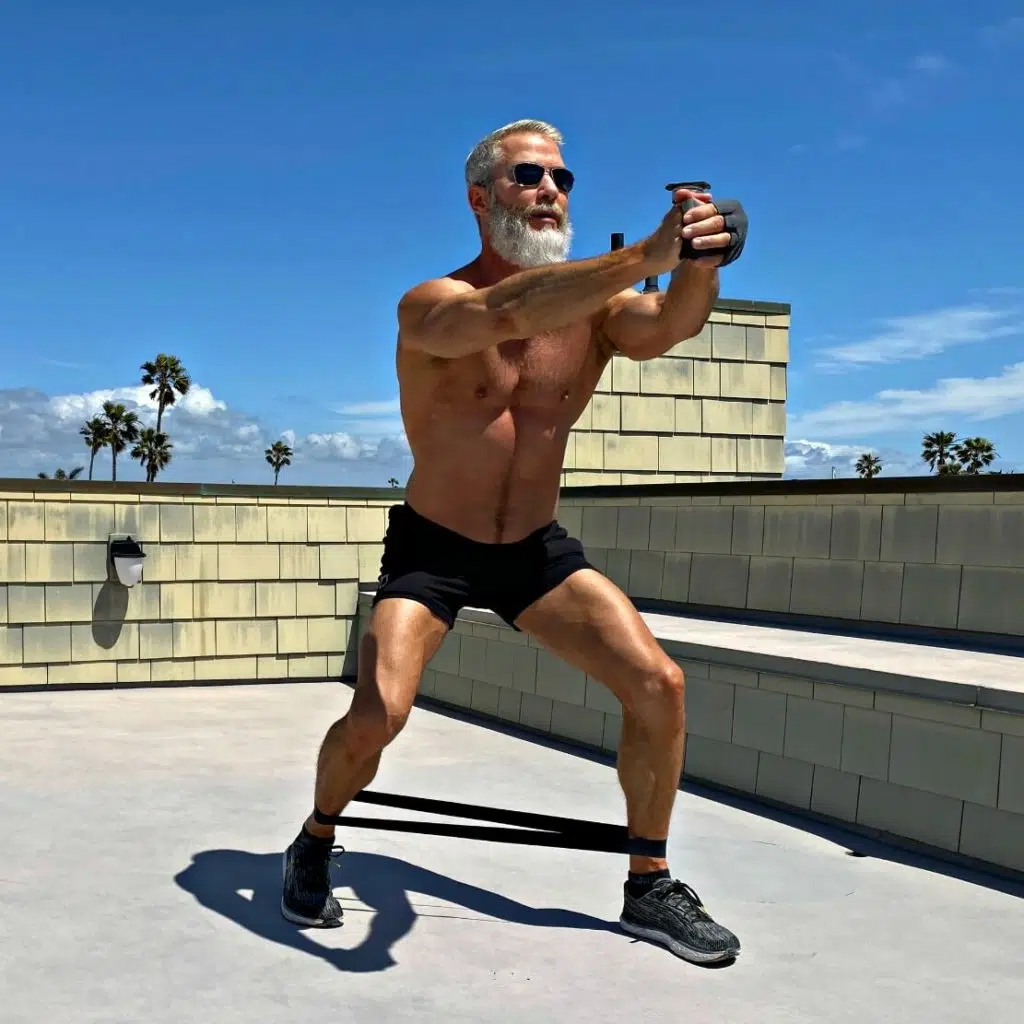
Rocky Balboas for the Thigh
With the band around your lower leg, take slow steps forward and out with very bent knees.
Walk forward 12 steps, walk backward 12 steps. (Or, if you’re in a small space, simply walk forward and back as often as possible to make 24 reps.)
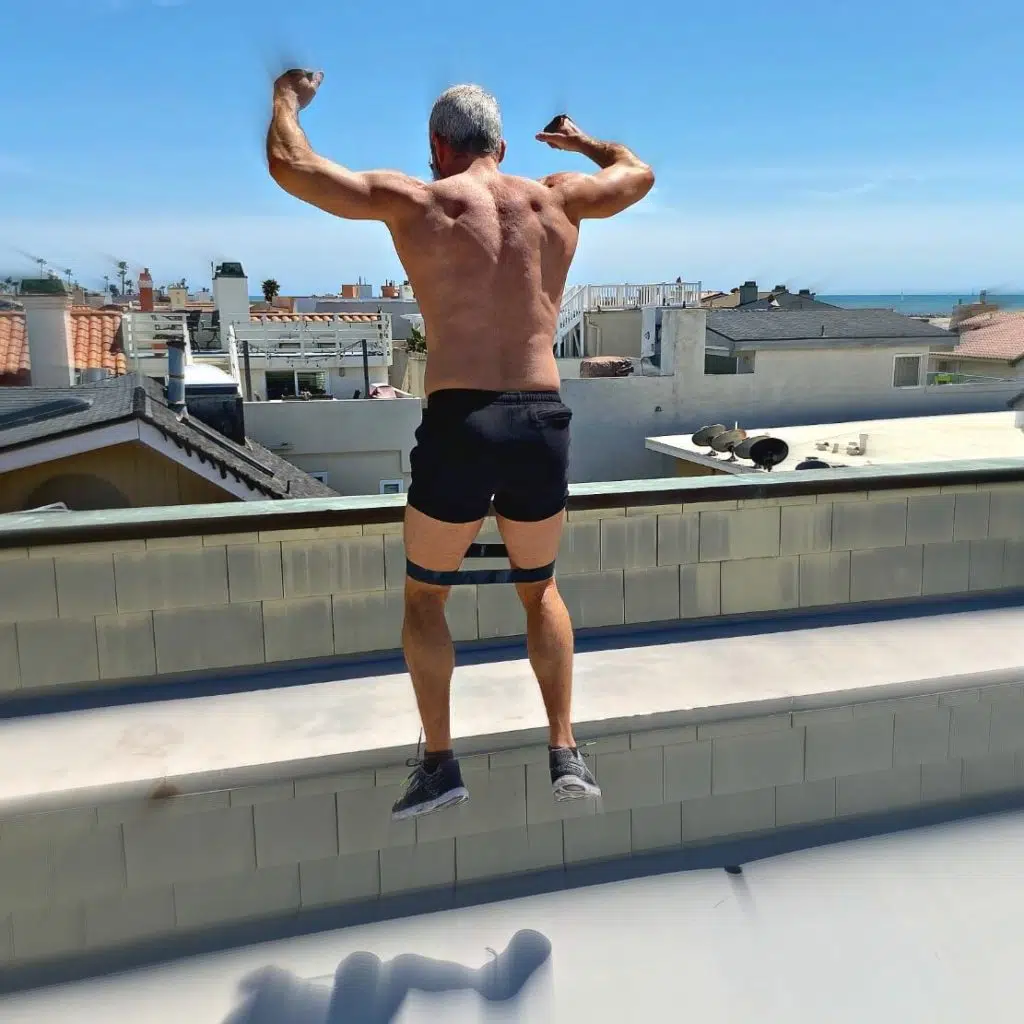
Jump Ups for the Leg
Anytime you jump up on a bench, ensure it’s secure. If you feel yourself getting tired or losing focus, then stop. It’s better to be safe. Concentrate during the jump up and also during the jump down. Land softly by engaging your core the entire time.
The band goes above your knees (that’s important).
12 reps.
Lower-Body Finishers Circuit with Resistance Bands
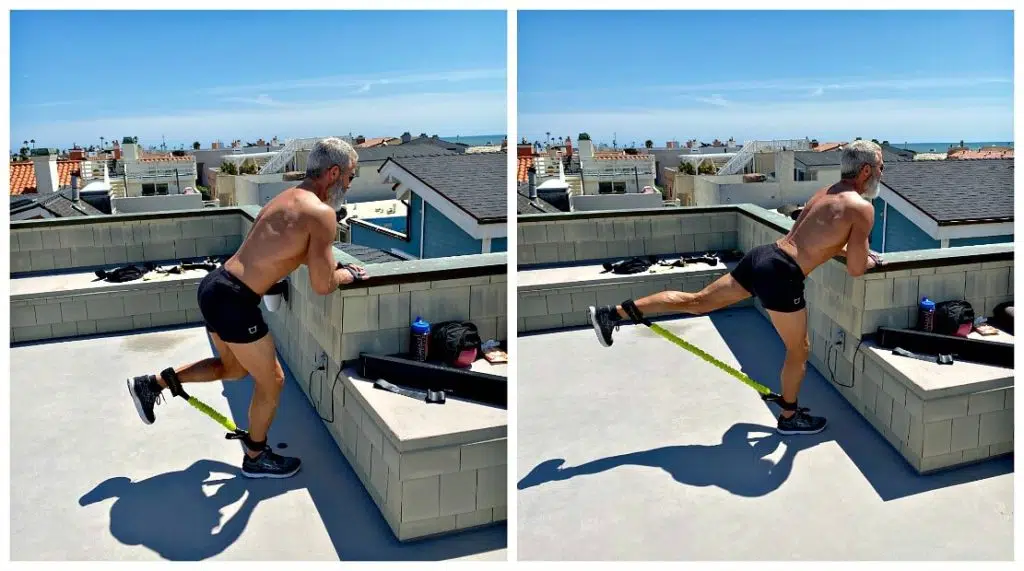
Best Glute Isolation Exercises: Donkey Kicks
As you press one leg back with a flexed heel, squeeze your buttock deeply once your leg is straightened.
Your supporting knee should remain slightly bent.
As an alternative to cuffed bands, you can use a regular looped band placed over the back of your heel.
14 reps each side.
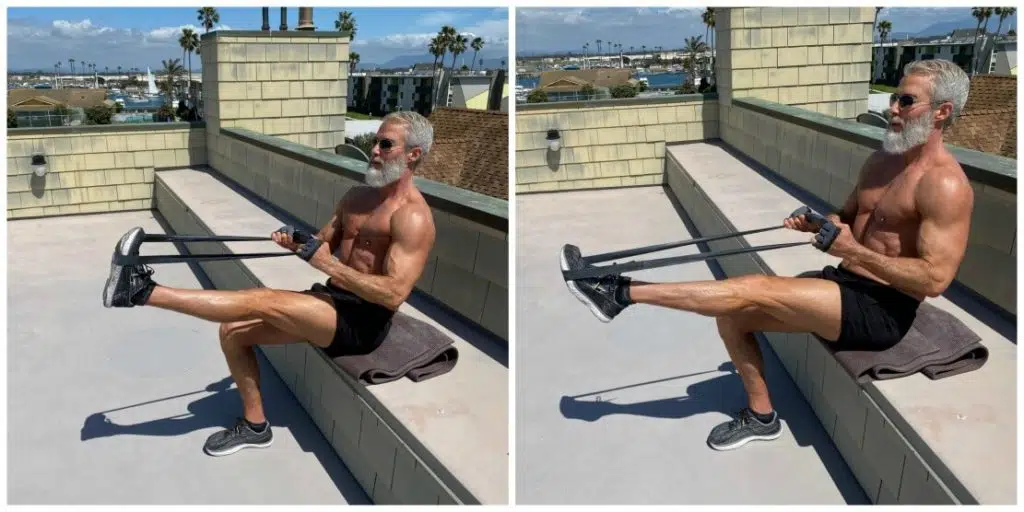
Banded Toe Points for Sculpted Calves
Exaggerate the range of motion on this toe-point exercise. Come back for a deep stretch, then super-point as you squeeze the calf muscle intensely.
16 reps each leg.
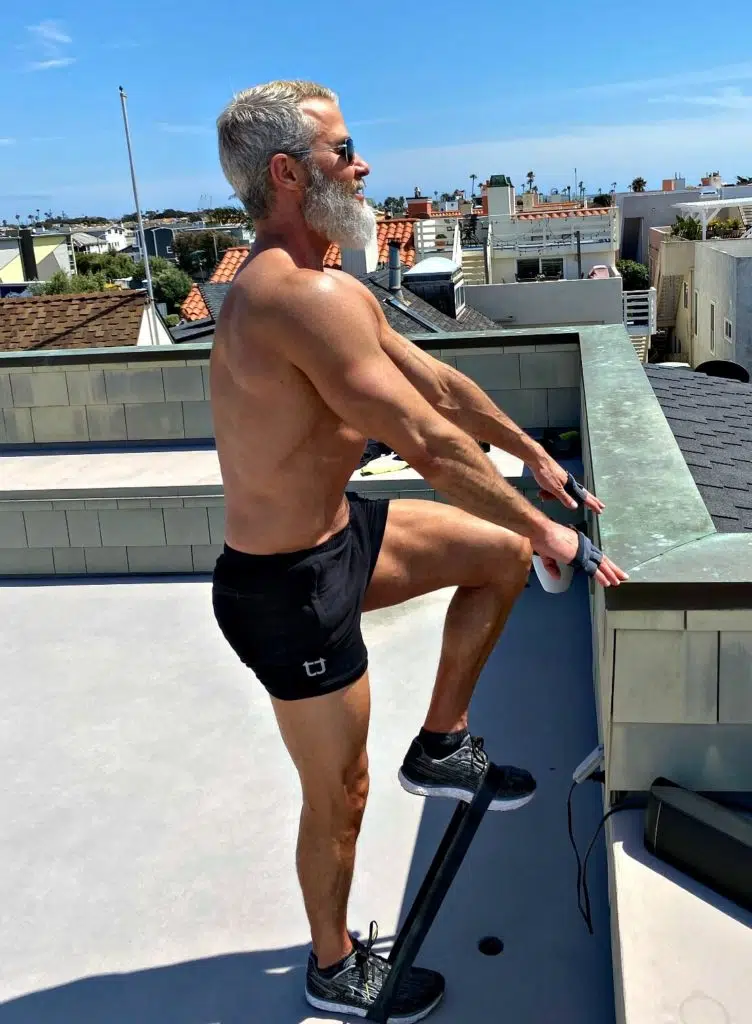
Knee Lifts for Hip Flexors
7 reps each side.
Refer to the video below for further instructions on doing each of these exercises.
Honoring Individual Leg Differences
Each human body is different, and each of us currently enjoys a different fitness level. You’re encouraged to listen to the unique needs of your own body. Beginners may need 4 minutes of rest between each circuit. Advanced athletes might need only 2 minutes.
Be mindful of your form.
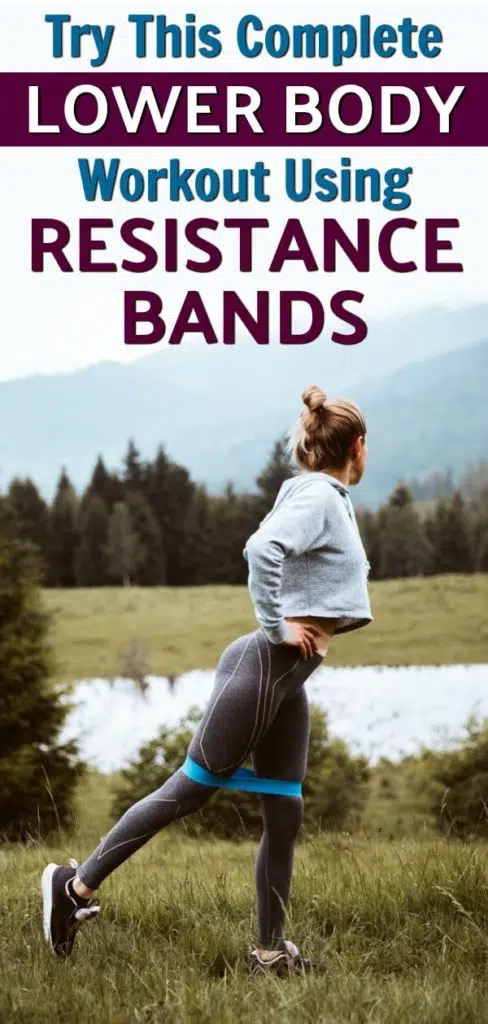
Try to be objective, as if you’re watching yourself exercise from a distance. Ask, “how is my posture at this moment?”
Each time you do a specific exercise, ask, “where am I feeling this?”
Remember that the glute muscle groups comprise different areas – gluteus medius and gluteus Maximus.
The hip thrust, the glute bridge, hip abduction, hip extension, and the fire hydrant – are the best glute isolation exercises because they work among various planes.
For additional ways to train your glute muscle groups:
- click the link to see how to use ankle weights.
- click the links on how to do compound movements such as back squats, Romanian deadlifts, Bulgarian split squats, kettlebell swings, and walking lunges.
If a particular exercise causes sharp pain, stop doing it. If you feel dizzy, stop exercising. As always, consult with your medical doctor before making significant changes to your exercise habits.
The above workout includes the best glute isolation exercises and uses resistance bands to sculpt your lower body muscles and helps them become stronger and firmer.
After completing this workout, you might consider using resistance bands for your upper body during your next workout.

